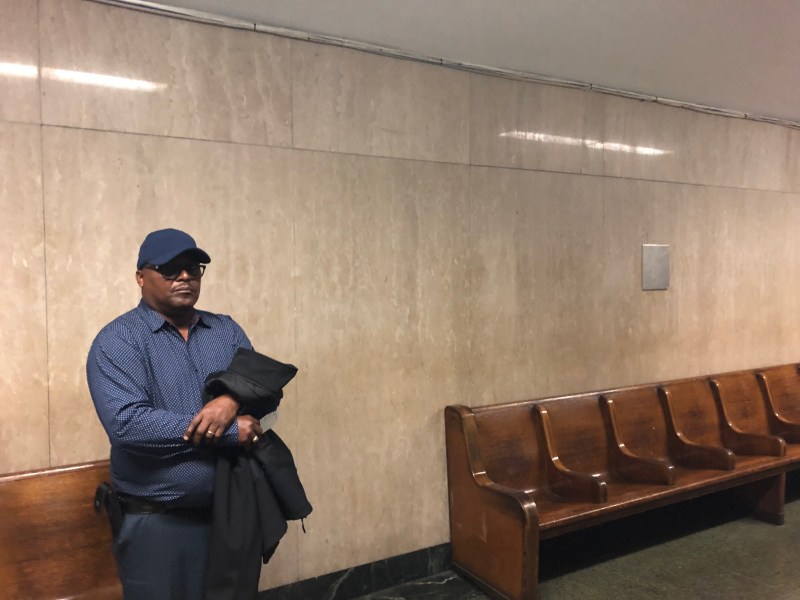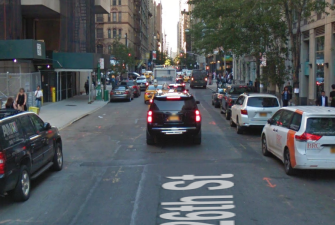‘Justice’: Killer of Citi Bike Rider Dan Hanegby is Guilty

The bus driver who killed Citi Bike rider Dan Hanegby last June was found guilty Monday of a low-level “right-of-way” charge, a small comfort for the victim’s family but at least a symbol of justice, cycling activists said.
Coach USA driver Dave Lewis was also convicted of the lesser charge, a violation for failure to exercise due care, Manhattan Judge Heidi Cesare ruled in the bench trial.
The conviction — which is rare in cases of drivers killing innocent cyclists — may not send Lewis to jail, as the top charge is a misdemeanor punishable by 30 days.
Hanegby’s widow, Sasha, cried and shook when the verdict was read and left the court quickly with lawyers, a small group of friends and family, declining to comment. But Paul Steely White, executive director of Transportation Alternatives, issued a statement calling the verdict “a measure of justice,” in part because police initially blamed the cyclist.
“Drivers are rarely held accountable for recklessly taking lives on New York City streets,” White said. “All too often, police hastily exonerate drivers while erroneously blaming bicyclists and pedestrians for their own deaths. We implore [NYPD] Commissioner O’Neill to bring an end to this habit of victim-blaming.”

Transit activists celebrated the passage of the Right of Way Law in 2014, even though the top penalty is relatively minor: up to 30 days in jail and $500 in penalties. Previously, unless an NYPD officer witnessed a crash, most drivers had to be intoxicated in order to face consequences.
The charge has been leveraged infrequently since its implementation: between 12 and 70 times annually, according to Marco Conner, legislative director for Transportation Alternatives. There were 34 arrests on the charge in 2017, down from 41 in 2016, according to the city’s latest Vision Zero report.
Hanegby, a 36-year-old father of two, was fatally run over on the morning of June 12, 2017, while riding a Citi Bike on West 26th Street between Eighth and Seventh Avenues. Surveillance video from a nearby building, first reported by Gothamist last summer and entered into evidence in Lewis’s trail, contradicts initial police reports that Hanegby “swerved” away from a parked vehicle before fatally colliding with the bus.

These accounts that Hanegby allegedly “swerved” into the bus appeared in the New York Times and Daily News, among other outlets, adding Hanegby to a list of traffic crash victims, including Lauren Davis and James Gregg, whose deaths were inaccurately reported in their immediate aftermath.
In surveillance footage, Hanegby is seen traveling straight near the middle of the roadway, possibly because a driver had left his black SUV jutting into the roadway. The bus overtakes Hanegby as he cycles between a white commercial van parked to his right and the SUV. Lewis passes rather than slows down through the pinch point, and the side of his bus nudged Hanegby’s handlebar. The cyclist’s front wheel jerks to the right just before he falls and is crushed to death.
In his closing arguments Monday, Lewis’s lawyer Jeremy Saland said that Hanegby was “oblivious” to Lewis honking, and that Lewis’s negligence could not be proved beyond a reasonable doubt. The over-the-ear headphones that Hanegby was wearing violate state law, Saland said.
“He’s not a bad person for this, but he was completely and totally unaware,” Saland said, of Hanegby.
Saland was also critical of key witness Lanette Perez, who sat in the front of the bus and testified that Lewis did not have room to safely pass Hanegby. Saland suggested that she “put herself front and center because she wanted to be a hero in the situation.”
In her response, Assistant District Attorney Raffaela Belizaire accused Saland of victim-blaming, and argued that Lewis’s decision to honk proved that he had “decided to pass” even though he was aware of the risk — a reading of the facts that could have earned Lewis a charge of reckless endangerment or criminally negligent homicide.
“Even if Mr. Hanegby had no hands and a blindfold on, he still had the right of way,” she said.
Belizaire said that the honking, which Lewis admitted to doing, is “the central issue in this case.”
“He honked precisely because he appreciated that the road was narrow and the cyclist could be hurt very badly.” He was, in short, aware of the risk, yet did not slow down to yield the right of way to the vehicle — Hanegby’s bike — that legally had it.
Hanegby was the first person to be killed while riding a Citi Bike since the inception of the program in 2013. An avid cyclist, he lived in Brooklyn Heights with his family and worked as a director of investment banking at Credit Suisse. He moved to the U.S. from Israel in 2000, and was once the top ranked tennis player in his home country.
Cyclist fatalities increased last year even as overall traffic fatalities decreased. Twenty-three cyclists died in 2017, a 10-year high and up from 18 in 2016. Ten cyclists have died so far this year, down from 18 over the same period last year.
Lewis was released and will be sentenced on Oct. 22. His attorney declined to comment on the ruling.
Manhattan DA Cyrus Vance Jr., who has come under fire for being inconsistent in his prosecution of drivers who kill, issued a statement after the verdict, saying he hoped it “brings a small measure of closure to Mr. Hanegby’s family and friends.”
He claimed he would “keep working with advocates and government partners until Manhattan streets are significantly safer for cyclists and pedestrians.”

